
2024 Outdoor Safety Tips: A Guide to Safe Outdoor Activities
In a world that thrives on technological advancements and fast-paced living, one constant continues to captivate and nourish our souls — nature. Heading outdoors, whether you’re hiking up a mountain or appreciating a stunning sunrise, has the huge benefit of lowering stress and anxiety.
Lots of people discovered (or rediscovered) nature during COVID-19 lockdowns, and that newfound love seems to have stuck. In 2023, the Outdoor Industry Association reported recent increases in diversity among outdoor participants and growth in categories such as camping, fishing, skateboarding, and sport climbing.
Of course, nature does have its downsides. Coming down with a sunburn or getting lost can put a serious crimp in your day. No thanks! Good thing you have this handy guide. Read on for tips so you don’t get attacked by bears or end up with horrible sunburn or a painful bout of chafing.
Expert Quotes on
Outdoor Safety and Health

Running
and Jogging
- Go with at least one other person or a dog
- Avoid wearing earphones
- Change up your route so you stay alert
- Run against traffic and obey all traffic rules and signals
- Carry mace or pepper spray if it is legal in your state (if not, try a folding knife)
- Warm up before starting the run or jog
- Stop right away if you notice trouble such as muscle pain
- Choose shoes that absorb shock and that provide good support
- Wear flexible or cushioned shoes if your feet are high arched
- Wear motion control or stability shoes if your feet are flat
- Pick shoes with extra stability, durability or traction if running or jogging in inclement weather
- Avoid cotton socks
- Run or jog on well-maintained trails instead of those populated with lots of fallen branches, poison ivy or overgrowth
- Avoid making eye contact if encountering an aggressive dog. Retreat slowly and calmly
- Carry a cellphone and whistle

Hiking
- Do a few easy hikes before undertaking a more complicated endeavor
- Pace yourself to conserve energy
- Wear waterproof boots with ankle support and thick soles
- Lace boots tightly but leave room to wiggle your toes
- Break boots in before hiking
- Hike with others
- Avoid days with extreme weather or temperatures
- Stay hydrated
- Choose snacks such as energy bars, trail mix and beef jerky
- Stay on the trail

Camping
- Check the weather report before you go camping
- Bring a first aid kit
- Bring emergency supplies such as a compass, map and insect repellent
- Arrive early so you have sufficient time to set up your shelter
- Choose a site with shrubs or trees to protect against wind
- Check the site for glass, bugs, poison ivy, ant beds and other no-nos
- Wash or sanitize your hands to prevent making others ill, especially before you handle food and after you’ve used the bathroom
- Make sure that someone is attending any fires at all times
- Keep fires far enough from the tent so that an errant flame or spark won’t catch the tent on fire
- Use tent fabrics that are flame retardant
- Keep your campsite clean to prevent wildlife from intruding
- Be aware of any poisonous plants that may be at the campsite

Swimming
- Stay out of the water unless you know how to swim
- Always swim with at least one other person
- Swim only where there are lifeguards
- Swim in a river or lake only if you have the strength to handle currents
- Float with a current if you get stuck instead of fighting it
- Dive in areas you know are safe
- Avoid jumping on others or pushing them
- Don’t drink alcohol

Bicycling
- Wear helmets that fit well and that meet safety standards
- Ride single file in the direction of traffic
- Watch for car doors
- Be extra careful at intersections
- Use hand signals to alert others to your moves
- Ride during the day whenever possible
- Wear bright clothing for visibility
- Wear reflective clothing if bicycling at night or in low light
- Use reflectors on the bike, and ideally, a horn/bell, rearview mirror and bright headlight
- Practice on your bike in car-free areas before venturing onto roads

Canoeing
and kayaking
- Wear a life jacket
- Go with at least two other people if using only one craft, or go with two crafts
- Work your way up to a new skill level instead of jumping into rapids or rivers you’re unprepared for
- Check water levels before you set out
- Know the features of the water (Low and slow or high or fast? Rocky crevices, hidden rocks, deep waters?)
- Sit on the seats
- Don’t stand when away from shore
- Reserve canoeing and kayaking for decent weather
- Pack first aid kits, extra clothes, maps, sunscreen, water and snacks in waterproof bags
- Tie your items to the canoe in case of a tip over
- Bring a canoeing whistle
- Bring a rope in case you need to tow another craft or pull someone in

Sledding
and tobogganing
- Wear a helmet
- Put on heavy boots and thick gloves
- Use sleds that have steering mechanisms and brakes
- Stay with children while they sled, especially if they’re 10 or younger
- Use equipment that is in good condition
- Don’t use equipment if it has cracks or sharp edges
- Choose gentle slopes with plenty of level room for the sled to stop at the end
- Avoid slopes with obstructions such as trees, poles, fences and rocks
- Avoid sledding in areas with ponds, rivers, streams and lakes
- Point your feet downhill instead of sledding head first

Skiing and snowboarding
- Wear helmets
- Don’t engage in risk-taking behavior
- Choose gear that fits properly and that is easy for you to adjust
- Choose functionality over appearance when it comes to clothing and equipment
- Choose snowboards with leashes and skis with brakes
- Dress in layers and wear bright colors
- Pick outerwear fabric that is slide resistant and water repellent
- Keep up a regular exercise regimen to minimize the chances of fatigue and injury
- Stop on the side of a run, never in the middle
- Give right of way to the skiers in front of you
- Look all around you and uphill before merging, crossing or starting down
- Avoid closed runs and avoid skiing into prohibited areas

Shoveling snow
- Take extra care if you’re older than 40 or not normally active
- Wait a while to shovel if you’ve just smoked or eaten
- Stretch first
- Begin slowly and quit before you’re exhausted
- Work only on snow that is powdery and fresh
- Push snow—don’t lift it unless you fill the shovel only halfway or are using a small shovel
- Lift with your legs instead of your back
Common Maladies for Outdoor Adventurers
If you’re going for a bike ride or hitting the trails, one of those common maladies could get you down:
Geez, hiking and biking don’t seem so appealing now, do they? Don’t worry, though. Let’s take a look at a few maladies from this list and see how they can be prevented. We’ll also look at other issues such as what to pack in your first aid kit and how to deal with lightning.
Sunburn
Sunburn can creep up on you no matter if you’re practicing your tennis backhand in the summer or skiing in the winter. Yes, it really is possible to get sunburn on cloudy or snowy days! Better to be safe than sorry, especially since long-term damage can accumulate even in skin that looks fine.
Wear sun/UV ray protection such as hats, sunglasses and even clothing
Wait 30 minutes after applying sunscreen to head outside
Apply sunscreen every two hours or after you get out of water, towel off or sweat heavily
Choose broad-spectrum sunscreen since it offers protection against both UVA and UVB rays
Use aloe vera products to soothe and heal sunburnt skin
If you’re bad at remembering to apply sunscreen, try setting phone reminders. Other options include sunscreen wristbands or stickers and UV patches. Another idea is to reapply your sunscreen whenever you break out a new bottle of water.
What SPF should you aim for? Use at least SPF 30, but aim for SPF 50 or higher if your skin is sensitive or you have a history of skin cancer.
As you can see from the table, it’s never possible to receive 100 percent sun protection with sunscreen. Don’t let “SPF 100” lull you into a false sense of security. Still follow all recommendations such as reapplying every two hours or whenever you come out of the water. SPF 100 sunscreen still washes off, and you should seek other sun protection measures such as taking advantage of shade and wearing hats.
Other common mistakes people make with sunscreen:
- Not applying enough
- Thinking it’s not necessary with darker skin
- Forgetting to apply it to critical spots
- Using expired sunscreen
- Thinking it’s OK for babies
Use about 1 ounce of sunscreen per lathering. That equals one shotglass.
Whoa.
That may seem like a lot! That’s because many folks don’t realize they’ve been under-applying. Suppose you’re at the beach all day. Ideally, you’d use about half of an 8-ounce bottle of sunscreen.
If you have darker skin, you still need sunscreen. Follow the guidelines no matter your skin color.
As for babies, keep them out of the sun until they’re six months old. Their skin is highly sensitive to the sun and to the ingredients in chemical sunscreen. Use shade and tightly woven clothing to protect them instead.
When you apply sunscreen, remember areas such as the back of your neck and legs, your ears and your lips. Skin cancers frequently show up in those areas because folks forget to protect them.
Now, if you’re already sunburnt—ouch. So sorry. It hurts, we know. Hopefully, you’ll get better soon. The American Academy of Dermatology recommends steps such as placing a cold, damp towel on the sunburn for 10 to 15 minutes a day and using moisturizer with soy or aloe vera.
Drinking water can prevent dehydration, and taking ibuprofen may help with pain and swelling. Avoid as much sun exposure as you can while you heal, and leave any blisters alone. Otherwise, they could become infected.
Bug Bites
When you’re outside, you venture into spaces occupied by creatures such as ants, spiders, flies, bees and mosquitoes. They can get “affectionate,” biting and stinging you, possibly also spreading disease. Oh, the joy!
Fortunately, a fun outing can stay just that—fun—with the proper precautions. Heed this advice from the American Academy of Dermatology and other experts:
Bringing Fido along? Make sure your dog is current on flea and tick medications, and check Fido over afterward for creepy crawlies. This way, bugs that are on the dog don’t end up biting you as well.
Of course, insect repellent is a must. Here’s what to do:
Choose repellent that has 20 percent to 30 percent DEET.
Spray it on your clothing and exposed skin (if pre-treating your clothing, give it two hours to dry before venturing out).
Follow the directions on the repellent labels.
Remember to reapply according to the directions.
Apply repellent after your sunscreen has dried.
Don’t use sunscreen that also contains repellent because each needs to be reapplied at different intervals.
When you already have a bug bite, seek treatment ASAP if the bite area is oozing, growing or becoming redder, which are signs of infection, or if the bite (or sting) is near your mouth.
Blisters
For outdoor adventurers, blisters are produced by:
- Bug bites and bug stings
- Pinched blood vessels
- Repetitive rubbing or friction, usually on the hands or feet
- Temperature extremes (burns and frostbite can lead to blisters)
Prevent blisters on your hands
Wear gloves or batting gloves to prevent blisters on your hands if you work outside with tools or play softball/baseball. If you’re a rower, tape up your hands. Talcum powder may be a helpful aid to gloves or tape or even as a standalone option, but don’t count on it to last long.
Prevent blisters on your feet
You may have to follow most, if not all, of the tips below to prevent blister formation on your feet and heels. It can take just one misstep for a blister to rear its ugly head.
If you have existing blisters, your best bet is usually to leave them alone to heal. It’s perfectly fine to cover them with gauze or bandages, but if you pop the blisters or poke at them, you risk infection.
In some cases, though, you may want to pop them. Here’s the scoop on when, why and how to do so.
Chafing
Chafing is a whole lot of fun! Ha ha. Actually, it’s not enjoyable at all, and numerous risk factors such as sensitive skin, large muscles, extra weight, humidity and hot weather mean that lots of folks have to deal with it. After all, it’s not possible to lose tons of weight overnight or to decree that your skin no longer be sensitive. Fortunately, you can reduce some risk factors such as badly fitting clothing and clothes that don’t wick moisture.
Problem spots tend to be on the thighs, armpits, groin and nipples. Take these steps:
- Stay as dry as possible.
- Apply skin lubricant to problem areas before starting an activity (apply it to your heart rate monitor strap too!).
- Wear wool fabrics or synthetics—no cotton.
- Wear sports bras that fit well and that have good seam placement.
- Place bandages over nipples.
- Avoid clothing with seams and tags.
- Wear clothing that is not too tight or too loose.
- Stay hydrated.
- Experiment with built-in briefs, compression shorts or going without underwear.
- Keep snug any straps on waistbands, running packs or backpacks.
If biking is your thing, wear bike shorts that have a built-in chamois. It’ll keep moisture away from your body. You can even put chamois cream or another type of skin lubricant on the chamois to cut down on friction.
Overheating
If you exercise in warm or hot weather, your body could overheat, possibly resulting in vomiting, nausea, muscle cramps, cold and clammy skin or heatstroke, which can be life-threatening.
If you show signs of heat exhaustion such as dizziness, headache, dark-colored urine, rapid heartbeat, nausea or muscle cramps, get out of the heat as soon as possible. Drink fluids, take a cool shower, bath or sponge bath, and use ice towels and other measures to cool your body.
If, 15 minutes later, you still feel the same as you did out in the heat, it’s time to see a doctor. Treat your heat exhaustion before it becomes heatstroke.
Heat exhaustion risk factors include being younger than 4 and older than 65, medications such as stimulants and diuretics, and health issues such as sunburn, diabetes, obesity and being underweight.
Lightning
Lightning often affects golfers, soccer players, boaters, fishers, campers, climbers and hikers. It’s a good idea to seek shelter right away when you hear thunder.
Other lightning safety tips:
Avoid metal bleachers, utility poles, golf carts, bicycles, motorcycles and horses.
Avoid carrying umbrellas, tennis rackets and golf clubs.
Get to a low spot if you’re in an open field. Crouch to get lower.
Avoid sitting or lying down because that means your body has more contact with the ground.
Wait 30 minutes after thunder has ended instead of assuming it’s safe to resume normal activity right away.
Stay away from bodies of water, golf courses and high ground if there is a chance of lightning.
Get off the water and seek shelter if a storm is about to happen.
Get to at least 100 yards from shore if possible.
Keep at least 15 feet between you and others in your group to reduce the chances of everyone getting struck.
Move downward as quickly as possible if you’re up high when lightning occurs.
Seek shelter in a forest rather than around solitary trees.
Set up your camping tent close to the shorter trees in the area rather than the taller trees.
First Aid Kits
Many outdoor activities such as camping naturally lend themselves to the need for first aid kits. In fact, there are prepackaged kits for all types of activities. You can also put one together yourself. Here’s a sample kit for hikers out on a lengthy trip, perhaps all day or multiday:
- Duct tape
- Lip balm
- Insect repellent
- Sunscreen
- Moleskin
- Aloe vera gel
- Aspirin and other pain relievers
- Antacid tablets
- Imodium
- Antihistamines
- Rubberized bandages
- Antiseptic towelettes
- Topical antibiotic ointment
- Cleansing pads with lidocaine
- Hydrocortisone cream
- Oral rehydration salts
- Resealable plastic bags
- Cotton swabs
- Safety pins
- Scissors
- Multi-use knife
- Adhesive tape
- Bandages
- Sterile dressing pads
- Closure strips and butterfly strips
- First aid booklet
If it’s a two-hour hike you’re going on, you may want to jettison many of these items. Of course, it’s always a good idea to keep items that can help with blisters and bug bites. First aid kits don’t have to be large or heavy. Figure out something handy that you can take on short ventures.
One more thing! Make sure your kit is waterproof.
Technology
When it comes to outdoor health and safety, technology can be a double-edged sword. For example, it has made clothes more lightweight and protective, enabling hikers to venture farther and into nooks and crannies. At the same time, technology can instill a false sense of security into adventurers. Yes, inexperienced hikers may be able to get farther than they would have before, but how might they react if the GPS batteries die or unexpected weather sets in? Are they assuming that helicopters can fly in and rescue them? That isn’t possible with many types of terrain.
All this is to say that technology is great, but don’t rely on it solely to have your back. Do activities that you have the skills and knowledge for, or do them with folks who know their stuff and who are happy to help you learn.
Did You Know? Some technology, like Medical Alert Systems, can track your GPS location with pinpoint-accuracy. This can help if you get lost or disoriented in the wilderness (so long as there’s a cellular signal). While a medical alert doesn’t replace a personal locator beacon, it can be helpful if you or your loved one are aging or are prone to falls. See our list of the best medical alert systems to learn more.
Getting Lost
Becoming lost may make for a funny story at parties, but that isn’t a good-enough reason to wander off. Lots of better ways to devise funny icebreakers!
To keep from getting lost or to deal with it if you do wander into the unknown:
Take a compass and map. If you’re lost, observe the details of your surroundings and any landmarks, and match them to the map.
Never go off a trail.
Stay calm. To keep your mind busy, think over how you reached your current location. It may be possible to retrace your steps or to rejoin a path.
Avoid walking aimlessly. It’s better to follow your compass and map, even if you feel they can’t be right. If that doesn’t make sense, like you’ve lost your map, head downhill with a stream or drainage system. Many times, this approach takes you to a safe path, but it can be dangerous. Do this only if you see no options other than walking aimlessly. Stay and rest if you’re hurt, exhausted (or nearly there) or if it’s nighttime.
If you’re prone to getting lost, pack at least a few of the following items in addition to your regular first aid and safety gear. Do bring a map and compass no matter what!
- Extra eyeglasses, clothing, socks and rain gear
- Trash bag (can function as a poncho)
- Extra food
- Foil (you can use it to signal for help and to form a cup to catch rainwater)
- Pocket mirror (a signaling aid as well)
- Whistle (signaling aid and can scare off wildlife)
- Flashlight
- Candle and waterproof matches
- Radio with batteries
- Space blanket
- Water purification tablets
Ravenous Bears and Other Wildlife
<
OK, so black bears aren’t really that dangerous to humans, but why have them sniffing around your picnic or campsite if you can help it? To stop bears and other wild animals in their tracks, try these techniques:
Avoid food odors. Use sealed or secure containers, and dispose of food properly. Some areas have bear-resistant trash containers.
Change into pajamas or other clothes after you cook. Otherwise, food odors might linger on your pajamas or clothing as you sleep.
Remember that toothpaste, lotion, soap and even bug spray give off “food” smells for wildlife. Keep them securely stored along with the clothes you wear for cooking.
Clean your pots and pans, and maintain a clean campsite.
Keep your dogs and other pets on a leash—always.
Wear tough boots and gloves in areas with lots of snakes if you need peace of mind in such spaces.
Be loud. Voices and a crackling campfire keep creatures away.
Bring flashlights and bear spray for your peace of mind.
What Now?
After reading this guide, staying inside where it’s safe and your skin won’t chafe may sound good. Before long, though, the outdoors will start calling you again. It doesn’t have to be dangerous—or too dangerous, if risk is part of the thrill for you. There are many steps you can take in advance to make a trip as safe and as fun as possible. Heck, if you’re able to protect yourself well against sunburn, blisters and chafing, you’re ahead of many other folks in terms of health and safety.

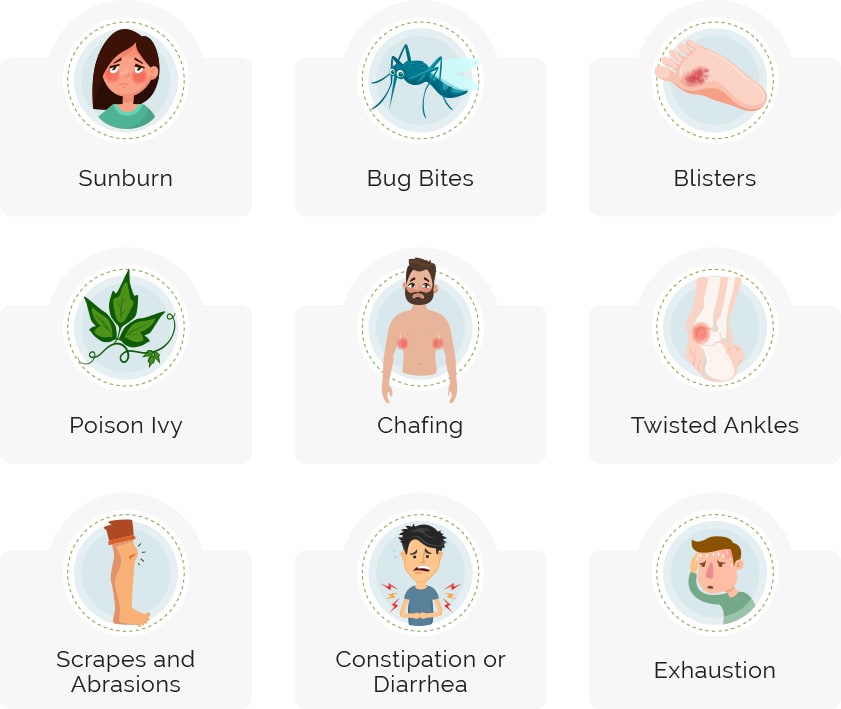
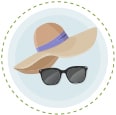 Wear sun/UV ray protection such as hats, sunglasses and even
Wear sun/UV ray protection such as hats, sunglasses and even 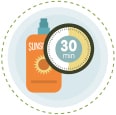 Wait 30 minutes after applying sunscreen to head outside
Wait 30 minutes after applying sunscreen to head outside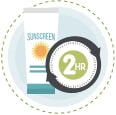 Apply sunscreen every two hours or after you get out of water, towel off or sweat heavily
Apply sunscreen every two hours or after you get out of water, towel off or sweat heavily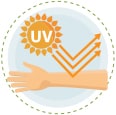 Choose broad-spectrum sunscreen since it offers protection against both UVA and UVB rays
Choose broad-spectrum sunscreen since it offers protection against both UVA and UVB rays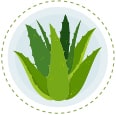 Use aloe vera products to soothe and heal sunburnt skin
Use aloe vera products to soothe and heal sunburnt skin
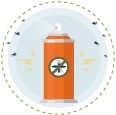 Choose repellent that has 20 percent to 30 percent DEET.
Choose repellent that has 20 percent to 30 percent DEET.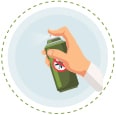 Spray it on your clothing and exposed skin (if pre-treating your clothing, give it two hours to dry before venturing out).
Spray it on your clothing and exposed skin (if pre-treating your clothing, give it two hours to dry before venturing out).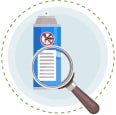 Follow the directions on the repellent labels.
Follow the directions on the repellent labels. Remember to reapply according to the directions.
Remember to reapply according to the directions.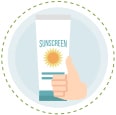 Apply repellent after your sunscreen has dried.
Apply repellent after your sunscreen has dried.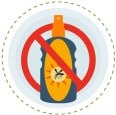 Don’t use sunscreen that also contains repellent because each needs to be reapplied at different intervals.
Don’t use sunscreen that also contains repellent because each needs to be reapplied at different intervals.


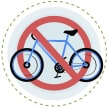 Avoid metal bleachers, utility poles, golf carts, bicycles, motorcycles and horses.
Avoid metal bleachers, utility poles, golf carts, bicycles, motorcycles and horses.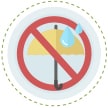 Avoid carrying umbrellas, tennis rackets and golf clubs.
Avoid carrying umbrellas, tennis rackets and golf clubs.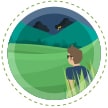 Get to a low spot if you’re in an open field. Crouch to get lower.
Get to a low spot if you’re in an open field. Crouch to get lower.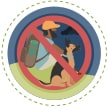 Avoid sitting or lying down because that means your body has more contact with the ground.
Avoid sitting or lying down because that means your body has more contact with the ground.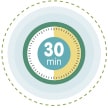 Wait 30 minutes after thunder has ended instead of assuming it’s safe to resume normal activity right away.
Wait 30 minutes after thunder has ended instead of assuming it’s safe to resume normal activity right away.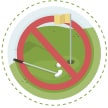 Stay away from bodies of water, golf courses and high ground if there is a chance of lightning.
Stay away from bodies of water, golf courses and high ground if there is a chance of lightning.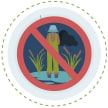 Get off the water and seek shelter if a storm is about to happen.
Get off the water and seek shelter if a storm is about to happen.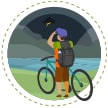 Get to at least 100 yards from shore if possible.
Get to at least 100 yards from shore if possible.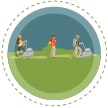 Keep at least 15 feet between you and others in your group to reduce the chances of everyone getting struck.
Keep at least 15 feet between you and others in your group to reduce the chances of everyone getting struck.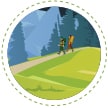 Move downward as quickly as possible if you’re up high when lightning occurs.
Move downward as quickly as possible if you’re up high when lightning occurs.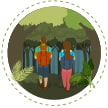 Seek shelter in a forest rather than around solitary trees.
Seek shelter in a forest rather than around solitary trees.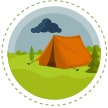 Set up your camping tent close to the shorter trees in the area rather than the taller trees.
Set up your camping tent close to the shorter trees in the area rather than the taller trees.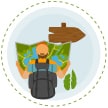 Take a compass and map. If you’re lost, observe the details of your surroundings and any landmarks, and match them to the map.
Take a compass and map. If you’re lost, observe the details of your surroundings and any landmarks, and match them to the map.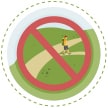 Never go off a trail.
Never go off a trail.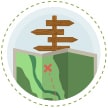 Stay calm. To keep your mind busy, think over how you reached your current location. It may be possible to retrace your steps or to rejoin a path.
Stay calm. To keep your mind busy, think over how you reached your current location. It may be possible to retrace your steps or to rejoin a path.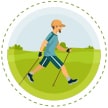 Avoid
Avoid 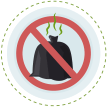 Avoid food odors. Use sealed or secure containers, and dispose of food properly. Some areas have bear-resistant trash containers.
Avoid food odors. Use sealed or secure containers, and dispose of food properly. Some areas have bear-resistant trash containers.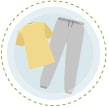 Change into pajamas or other clothes after you cook. Otherwise, food odors might linger on your pajamas or clothing as you sleep.
Change into pajamas or other clothes after you cook. Otherwise, food odors might linger on your pajamas or clothing as you sleep.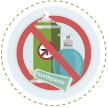 Remember that toothpaste, lotion, soap and even bug spray give off “food” smells for wildlife. Keep them securely stored along with the clothes you wear for cooking.
Remember that toothpaste, lotion, soap and even bug spray give off “food” smells for wildlife. Keep them securely stored along with the clothes you wear for cooking. Clean your pots and pans, and maintain a clean campsite.
Clean your pots and pans, and maintain a clean campsite.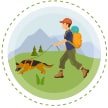 Keep your dogs and other pets on a leash—always.
Keep your dogs and other pets on a leash—always.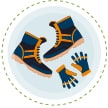 Wear tough boots and gloves in areas with lots of snakes if you need peace of mind in such spaces.
Wear tough boots and gloves in areas with lots of snakes if you need peace of mind in such spaces.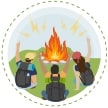 Be loud. Voices and a crackling campfire keep creatures away.
Be loud. Voices and a crackling campfire keep creatures away.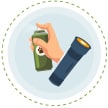 Bring flashlights and bear spray for your peace of mind.
Bring flashlights and bear spray for your peace of mind.